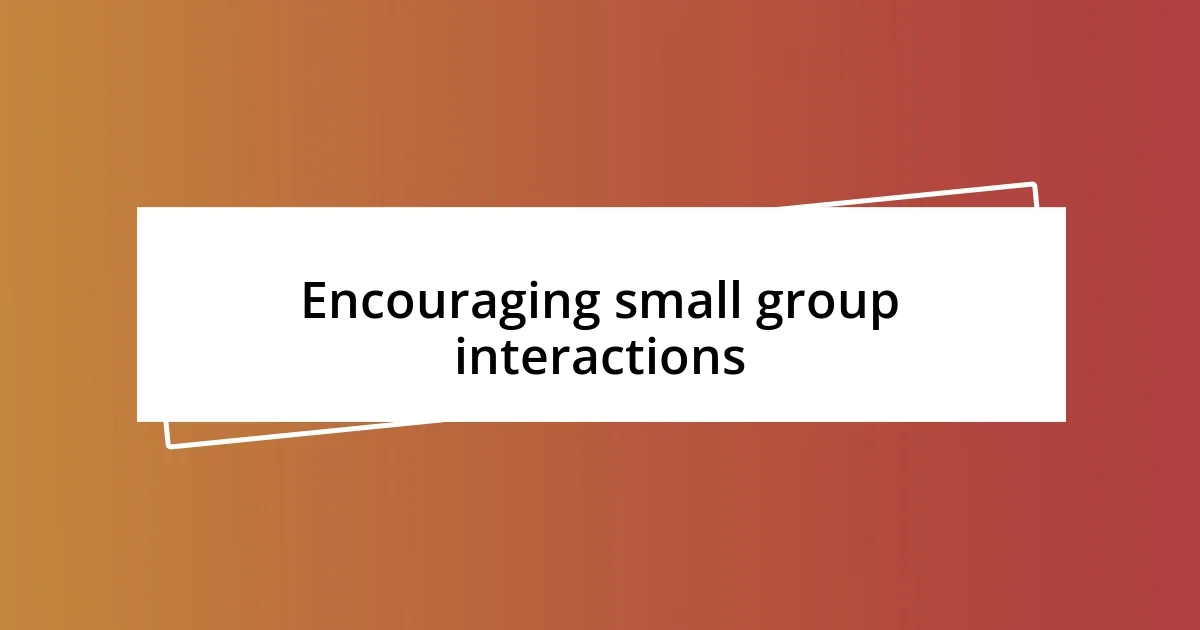Key takeaways:
- Understanding the underlying causes of shyness in players helps create a supportive environment that encourages participation.
- Recognizing signs of shyness, such as avoiding eye contact and hesitant responses, can guide efforts to foster inclusion and confidence.
- Using positive reinforcement and personal follow-ups reinforces players’ contributions, boosting their confidence and encouraging greater engagement.

Understanding shyness in players
Understanding shyness in players is essential for fostering a supportive environment. I remember one particularly shy player who would barely speak during practice. At first, I wondered if it was just a lack of confidence, but I soon realized there was so much more beneath the surface—perhaps fear of judgment or anxiety about making mistakes.
Shyness can often stem from previous experiences, which is something I’ve noticed in many players. For instance, I once coached a talented athlete who excelled in one-on-one situations but struggled during group activities. I found myself asking, “What happened in their past that made them hold back?” This realization opened my eyes to the layers of shyness, revealing how personal history can impact current behavior.
When we understand that shyness is not just about being quiet but often reflects deeper emotions, we can genuinely connect with players. It’s like peeling back the layers of an onion; each layer reveals unique fears and insecurities. I invite you to reflect on this: How have you seen shyness manifest in your interactions or coaching sessions? Recognizing these nuances can be a powerful tool in encouraging more participation.

Recognizing signs of shyness
When I observe a shy player, I often notice subtle cues that indicate their discomfort. For example, avoiding eye contact and fidgeting are common behaviors I’ve seen. One player I coached would always glance away when addressed, which made me realize that their shyness wasn’t just about being introverted; it was a protective mechanism in response to feeling overwhelmed.
Another sign to look out for is how shy players respond to participation opportunities. In my experience, they might hesitate to raise their hands or even give a soft-spoken response. I recall coaching a young athlete who would mumble answers or seek confirmation from a peer before speaking up. This behavior, I learned, often stems from fear of being wrong, and it was a clear indication that they needed some encouragement to build their confidence.
It’s crucial to recognize that shyness can manifest differently based on the individual’s personality. Some shy players may physically retreat, standing away from the group, while others might silently observe, absorbing everything around them. I remember a particular basketball practice where one quiet player chose to sit apart and watch rather than engage with the drills. This isn’t just shyness; it’s a clear sign of feeling out of place, and understanding these signs can help us create a more inclusive atmosphere.
| Signs of Shyness | Description |
|---|---|
| Avoiding Eye Contact | Players may look away or down when spoken to. |
| Hesitant Responses | Soft-spoken answers or reluctance to participate in discussions. |
| Physical Retreat | Standing away from the group or sitting aside during activities. |

Creating a supportive environment
Creating a supportive environment is vital for encouraging shy players to engage. I recall a time when I noticed a shy player sitting alone on the sidelines, her eyes downcast. Instead of pointing out the group activities she was missing out on, I approached her casually, complimenting her unique dribbling skills. Instantly, I saw a flicker of recognition in her eyes, as if someone truly valued her contribution. By fostering a supportive atmosphere, I’ve learned that just a little encouragement can spark confidence in those who often remain in the background.
Here are some key aspects that contribute to creating a nurturing environment for shy players:
- Encouragement Through Praise: Offer specific praise when shy players make contributions, no matter how small. This builds their confidence gradually.
- Peer Support: Encourage active players to reach out to their quieter teammates, helping them feel included in discussions and activities.
- Safe Spaces: Create opportunities where players can express themselves without the pressure of large audiences, like small group discussions or one-on-one chats.
- Positive Reinforcement: Celebrate even the smallest achievements in a public setting, such as during practice, to reinforce their sense of belonging.

Encouraging small group interactions
Encouraging small group interactions is one of the most effective strategies I’ve found for helping shy players open up. I remember a time when I divided my team into pairs for a quick passing drill. Initially, I noticed a quieter player hesitating to engage with her partner. To ease the tension, I casually introduced a fun challenge, suggesting they create their own passing routine. It was remarkable to see her face light up as she began to collaborate. This small shift not only fostered interaction but also built her confidence over time.
I’ve also learned that creating purposeful discussions within small groups can be incredibly impactful. During one practice, I implemented a ‘talking circle’ where players shared their thoughts on a recent game strategy. It was a revelation for me to see how the quieter players slowly began to share their ideas when they felt the pressure of a larger crowd lifted. The intimate setting allowed them to express themselves without the fear of being overshadowed. I often wonder, how many hidden talents go unrecognized in larger groups? Just making the effort to condense the focus often reveals gems of insight from those who might otherwise remain silent.
Moreover, I find humor can be an incredible icebreaker in small group settings. One day, I encouraged my players to share a funny story from their past—something light-hearted that could spark laughter and camaraderie. As they took turns sharing, I noticed the shy players starting to come out of their shells. They began to relate and even built friendships during that simple exercise. By cultivating an environment where fun and connection are prioritized, I’ve seen shy players blossom in ways I never thought possible. It makes me reflect: isn’t it fascinating how a small shift in dynamics can transform participation?

Using positive reinforcement techniques
Using positive reinforcement techniques can transform the way shy players perceive their role within the team. I remember during practice, a quiet player hesitantly made a solid pass. Instead of glossing over it, I called out specifically what I appreciated about that pass. I could see her face brighten—a subtle nod to the fact that recognition matters. This small but meaningful reinforcement encouraged her to take more risks in her game.
I’ve also realized that celebrating milestones, even the tiny ones, builds a sense of collective achievement. Once, I set up a “Player of the Day” recognition during practice. The shyest member of my team earned this for showing up consistently, and when I highlighted her dedication in front of everyone, the room erupted in genuine applause. It was more than just a pat on the back; it was a moment that bonded the entire team and instilled a deeper sense of belonging. Doesn’t it make you wonder how often small acts of recognition can spark larger waves of participation?
Moreover, I strive to create individual reward systems tailored to each player’s preferences. For instance, after observing a hesitant player trying out a new drill, I offered her a simple note of appreciation. That one gesture seemed to unlock a floodgate of enthusiasm. The next practice, she started leading drills herself and even encouraging her teammates. It’s a compelling reminder that sometimes, reaching out with simple affirmations can kick-start a shy player’s confidence and commitment. Have you ever witnessed such a transformation? It really bolsters my belief in the power of positive reinforcement in sports.

Introducing games that promote participation
Introducing engaging games can be a game-changer for encouraging participation among shy players. I recall a day when I introduced a team-building game called “Balloon Keep-Up” during a practice. Players were tasked with keeping a balloon in the air while navigating through obstacles. What struck me was how this non-competitive environment lowered their guard; everyone laughed and cheered for each other. Suddenly, the focus shifted from personal performance to collective enjoyment, and shy players began to shine as they offered strategies and solutions to keep the balloon afloat. Isn’t it incredible how a little fun can dissolve hesitations?
Another game I’ve found effective is “The Hot Seat.” In this activity, one player sits in the center and answers fun, non-intrusive questions from their teammates. The first time I tried it, I could feel the tension in the air as I pulled a shy player into the spotlight. However, the simple, light-hearted questions led to genuine laughter. Their smile grew wider as teammates shared funny anecdotes and inside jokes. I was amazed at how quickly they transformed from a quiet observer into an enthusiastic participant. Have you ever seen someone come alive in a relaxed setting? It’s heartwarming to witness.
I often mix in games that allow for creativity, like “Design Your Play.” Players work in pairs to come up with an innovative play for the next practice. When I first tried this, I watched as hesitant participants pulled out all sorts of ideas, supported by their partners. It was fascinating to see how energized they felt crafting something together. The excitement was contagious, and it made me realize: when shy players have the right tools to express themselves, they contribute just as much as their more vocal teammates. Isn’t it rewarding to unlock hidden potential through play?

Following up with personal encouragement
Following up with personal encouragement can really amplify the positive effects of any recognition I give. I remember a shy player who made a noticeable effort during scrimmage; after practice, I took a moment to tell her how proud I was of her progress. I noticed she seemed to light up at that personal touch—it’s those small follow-ups that reaffirm to players that their contributions are truly valued. Have you ever seen just a few kind words change someone’s day?
After giving praise, I make it a point to check in with shy players regularly. After recognizing a shy player for their effort, I followed up by asking how they felt about their performance. One time, she shared her surprise at how much fun she had. It was gratifying to know that my encouragement helped boost her confidence. Engaging in these conversations not only reinforces her achievements but also builds a rapport that invites her to open up more during practices. It’s fascinating how these personal connections can foster a supportive environment.
I also try to make personal notes a part of my follow-up strategy. Once, I left a handwritten note in a player’s locker, highlighting her efforts during a recent game. The next practice, she approached me with a huge smile, saying the note made her feel like a key part of the team. It’s little gestures like this that can carry immense weight. Isn’t it interesting to think about how something so simple can deepen a player’s sense of belonging and encourage more active participation?













